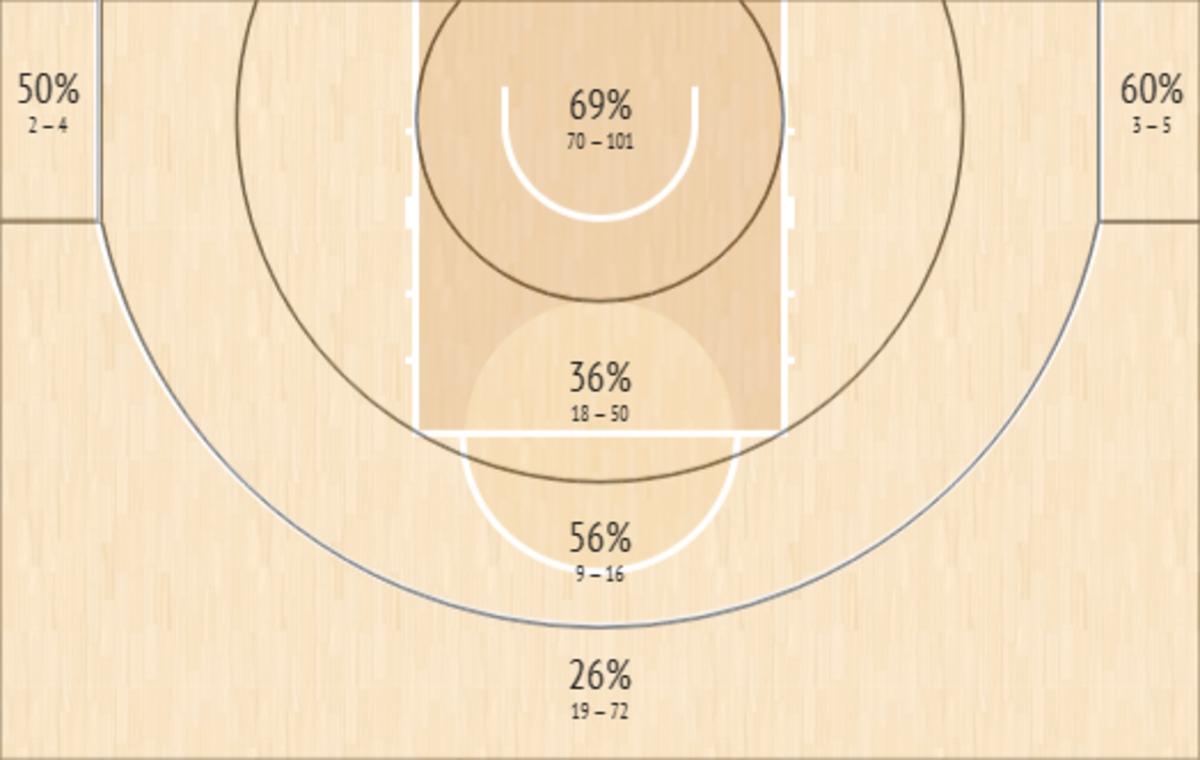The Map of Victor Wembanyama: Catch-and-Finish Scoring

The Map of Victor Wembanyama is a series where I try to identify the smaller aspects that comprise each skill of the projected number one pick in the 2023 NBA Draft. I look at how Victor can utilize each micro-skill to be valuable at the NBA level and which micro-flaws opposing teams could utilize to gain an advantage whenever he’s on the floor.
In the first installment of the map I talked about Victor’s interior defense and in this installment, we’ll look at the other side of the ball.
This is The Map of Victor Wembanyama, Part Two: Catch-and-Finish Scoring.
1. Catching Ability
Just like the previous installment of the map, I will start this region by stating the obvious: Victor Wembanyama is massive. Listed at 7-foot-4 with a reported 8-foot wingspan and a near 10-foot standing reach, Victor’s measurements not only make him an incredibly productive rim protector but also a tremendously impactful interior player on the offensive end of the floor.
Victor’s length, standing reach and hand size allow him to catch everything in his general vicinity, making it extremely easy for teammates to find him in the paint and allowing him to save errant passes that would be turnovers if directed to any other player.
There’s another layer to his catching ability and it puts opposing teams at a constant schematic disadvantage. No matter where he is on the court, Wembanyama seems to always be one pass away from the ball, as he’s simply able to catch passes at heights that opposing defenders can’t reach.
Conventional wisdom says that when you are guarding a player who is two passes away from the ball, you should sag off him in order to be in a better position to help in case of dribble penetration and to increase defensive pressure from the weak side. However, how do you help as a defender when your assignment is always one pass away from the ball?
You don’t. Or at the very least, you shouldn’t.
2. Dunker Spot Finishing
Due to his incredible measurements and his quick vertical pop for his size, Wembanyama is a massive threat when he gets the ball in the dunker spot, needing very little time and space to load up and finish over defenders.
When he’s off the ball, Wembanyama has the instincts and the spatial awareness to clear out the paint for drivers, dragging his man out of the way and putting himself on the right spots to catch the ball uncontested in case his defender attempts to sag off of him.
But as I mentioned, helping off of Victor is just a mistake, if he gets just one step after catching the ball, he can and will dunk over defenders emphatically thanks to his aforementioned measurements and vertical leaping ability.
If Wembanyama gets paired with a perimeter player who can consistently beat opponents in the perimeter in one-on-one situations, his threat to catch lobs will put opposing bigs at a disadvantage, as they will be in a pick-your-poison situation, having to choose between helping off Victor or staying with him and not rotating to contest the drive.
3. Pick-and-Roll Finishing
Wembanyama’s ability to catch difficult passes and to finish with consistency at the rim as soon as he gets any sort of momentum also makes him a nightmare in pick-and-roll plays. Victor commands just as much attention as a screener as he does when he’s hanging around in the dunker spot.
If the screen defender switches onto the ball-handler, then Wembanyama will slip the screen and roll to the basket with a level of momentum that makes him extremely difficult to stop without fouling.
The coaching staff at Metropolitans 92 has also done a good job this season by utilizing Spain Pick-and-Roll (aka. “Screen the Screener”) actions to create open lanes for Wembanyama to roll to the basket, allowing him to gain even more momentum in order to catch lobs on his way to the rim.
4. Hangtime
When defenders are not helping off of him, Wembanyama offers a level of hangtime, flexibility and touch in tough shots, which, combined with his tremendous measurements, allows him to finish against contact and length.
While Wembanyama doesn’t have the highest vertical leap (not that he needs to, anyways), he has an incredible level of hangtime for his size, which allows him to maneuver mid-air to correct misses, protect the ball from getting spiked by rim protectors and find the open space to convert difficult lay-ups.
His touch while airborne is not just accurate but it’s also quick. He’s able to solve situations at the rim, being able to cup the ball and send back misses with the accuracy of a volleyball player executing a soft spike. This level of mid-air touch under pressure makes him a threat in particularly difficult situations like cuts, lobs in traffic and contested offensive rebounds.
5. Offensive Glass
All the aforementioned skills (catching ability, hangtime, vertical leaping and touch against contact) seem to conflate every time Wembanyama chases an offensive rebound.
His massive standing reach allows him to make high-point catches that are nearly uncontestable for any opponent. In a way, Wembanyama knows that he is likely to win any aerial combat due to his massive measurements, so opposing teams have to battle on the ground: every one-on-one battle in the offensive glass will go his way unless you put a body on him and box him out properly.
Once Wembanyama gets in contact with the ball, his ability to solve situations while airborne allows him to send the ball back on tip-ins with good accuracy against contact, without bringing the ball down where opposing defenders could attempt a steal.
If it fails, however, Wembanyama can correct with his quick second jump to follow misses, as he’s able to load up quickly and elevate again before opponents can.
When Wembanyama is away from the play, his combination of mobility and size allows him to gain momentum and become difficult to stop when attacking the glass from a few feet away from the rim, as he’s able to fly in for emphatic putback dunks.
Final Thoughts
In the paint, Wembanyama is just as impactful as an offensive player as he is as a defensive player. Currently shooting 69% in the restricted area, he is not just efficient but also prolific on this zone, getting about 9.3 points per game on an average of 6.7 attempts.

With his catching ability, touch, hangtime and quick leaping ability, Wembanyama projects as an elite catch-and-finish player at the rim. His scoring ability is likely to present a schematic challenge for opposing teams, as he is too efficient in the restricted area to sag off of him, which means that teams will have to find a way to keep him in check every time he’s on the floor.
With his lack of strength and high center of gravity, putting a body on Wembanyama and preventing him from getting to the basket seem to be the most effective ways to deter him from scoring at the rim. While it certainly hasn’t worked for teams during this season when it comes to his catch-and-finish ability, it has hindered him to a certain degree when it comes to his self-creation in the post, an area that will be explored on the next iteration of The Map.
Want to join the discussion? Like Draft Digest on Facebook and follow us on Twitter to stay up to date on all the latest NBA Draft news. You can also meet the team behind the coverage.
